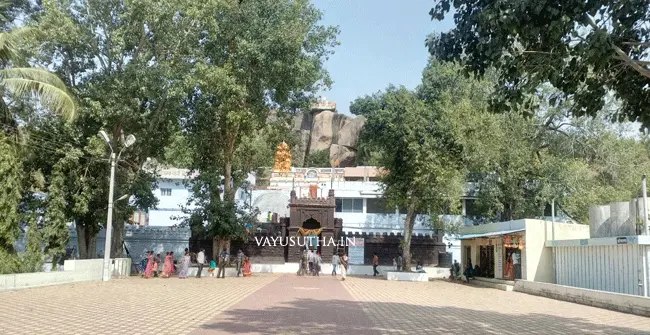
photo courtesy: Sri D.Srihari, Postal Department, Vijayawada.
Sri Samarth Ramadas
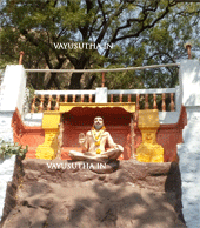 Saint Shri Samarth Ramdas was born in 1608 A.D. He was born on the auspicious day of Ramnavmi in the village Jaamb of Marathwada. He was the second son to the pious couple Suryaji Panth and Renuka Bai. His parents named him Narayan. He deserted his family and went to Nashik so that he could avoid marriage.
Saint Shri Samarth Ramdas was born in 1608 A.D. He was born on the auspicious day of Ramnavmi in the village Jaamb of Marathwada. He was the second son to the pious couple Suryaji Panth and Renuka Bai. His parents named him Narayan. He deserted his family and went to Nashik so that he could avoid marriage.
He was just thirteen years of age when he came across the place where the ‘Nandini’ Rivulet confluence with River Godavari. The place named Takli was considered sacred by many as many sadhus used to meditate in this holy place. In the year 1621, on sukla saptami [radha saptami] of the Magh month of the Hindu lunar calendar, he started his meditation on Sri Rama at this holy place. People started recognizing him as Sri Ramadas because of his devotion to Sri Rama and Sri Maruti.
For more details read “Brief Biography of Sri Samarth Ramadas" on our web site.
First mutt of Samarth at Takli
After spending twelve years in Takli and meditating upon Sri Rama he had many followers devoted to his teaching of Sri RamBhakti. While interacting with residents, he understood the sufferings and needs of people. He realised that it is imperative to reorient people towards the Sanadhana Dharma of the land. To bring about the desired changes Bhakti towards Sri Rama is the means. To muster confidence and alertness, prayers to Sri Maruti are a must. Hence, Maruti deity was established at Takli. This led to the development of the first Mutt of Samarth at Takli. To understand the true sufferings of people, he decided to travel across the Bharat Varsh and interact with them in person.
For more details on his stay at Takli read “Gomay-Maruti – Sri Samarth Ramdas Mutt, Takli, Nashik, Maharashtra” on our web site.
Journey towards change
In the year 1632, he left Takli to start his spiritual journey. He journeyed for twelve years throughout Bharat varsh, observing the people. He found that frequent floods and famines had led to great suffering of the people. In addition, he observed that wanton and indiscriminate attacks by Muslim rulers had destroyed the society. Based on his experiences he wrote two books, Asmani Sultani and Parachakraniroopan. These are the only two books in Indian Saint Literature that describe the situation of Bharat Varsh during those years.
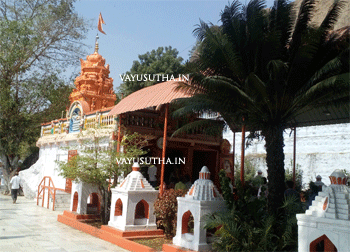 He started his journey from Takli and went to Karaveera kshetra [Kolhapur] to offer his prayers to Sri Ambaji Bhawani. Subsequently, he went to Brahmagiri the starting point of River Gadavari. Then he journeyed for some distance along the length of river Godavari. One such place where Swami Samath Ramadas had visited belongs to the current Nizamabad district of Telangana. This place was known as Indur. This name originated from King Indradatta who flourished in this region during those years. Sri Samarth Ramadas had stayed in a place called Bhodan in the Indur region.
He started his journey from Takli and went to Karaveera kshetra [Kolhapur] to offer his prayers to Sri Ambaji Bhawani. Subsequently, he went to Brahmagiri the starting point of River Gadavari. Then he journeyed for some distance along the length of river Godavari. One such place where Swami Samath Ramadas had visited belongs to the current Nizamabad district of Telangana. This place was known as Indur. This name originated from King Indradatta who flourished in this region during those years. Sri Samarth Ramadas had stayed in a place called Bhodan in the Indur region.
Bhodan
Bodhan was previously known as Eka Chakrapuram. This fertile land displayed rich culture and heritage and had many temples. When Samarth Ramadas visited this place, it was under the rule of Nizam. There has been no rain for the last few years in this region thus making people’s life miserable. A few people from the nearby village named Sarangapur which is a few miles away from Bodhan visited Swami Ramadas and informed him of the acute hardship they were facing in their village. After hearing them, Samarth decided to visit the village. He installed Sri Maruti in Bhodan and established a mutt at Bhodan under his disciple Uddahav.
Sri Samarth carved the outline of Sri Maruti on the rock there and then covered the carving with his sacred cloth. He asked the assembled Brahmins to offer their prayer to Sri Maruti. After a while when he took his cloth away, the outline carved by Sri Samarth had by then turned into a beautiful sculpture of Hanuman!
Sarangapur village near Bhodan
Sarangpur village near Bhodan had rocky land. Owing to the lack of rain, all the lakes and tanks in and around the village had dried up. There was severe drought in the village and people could not cultivate any crop in their lands. Since there were no crops grown, no tax could be collected. Hence, the ruler Nizam ordered all the Brahmins in the area to pray for rain and threatened that if it did not rain he would impose lifelong imprisonment on them. All the Brahmins stood in the dried lake for days together praying all the while, but there was no sign of rain.
Sri Samarth’s prayer to bring rain
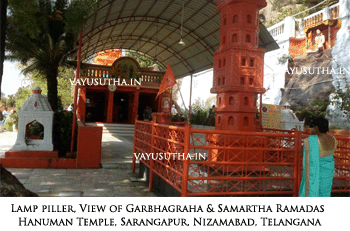 When Sri Samarth visited the village and saw the plight of the people, he decided to save the people and offered his prayers to Sri Rama. He carved the outline of Sri Maruti on the rock there and then covered the carving with his sacred cloth. He asked the assembled Brahmins to offer their prayer to Sri Maruti. After a while when he took his cloth away, the outline carved by Sri Samarth had by then turned into a beautiful sculpture of Hanuman!
When Sri Samarth visited the village and saw the plight of the people, he decided to save the people and offered his prayers to Sri Rama. He carved the outline of Sri Maruti on the rock there and then covered the carving with his sacred cloth. He asked the assembled Brahmins to offer their prayer to Sri Maruti. After a while when he took his cloth away, the outline carved by Sri Samarth had by then turned into a beautiful sculpture of Hanuman!
When the prayers were continuing it started raining. After a while, it started raining torrentially. It is needless to say the people of the village were thrilled and overwhelmed with joy.
Sri Samarth had also subsequently established Bada Sri Rama temple in the fort nearby and presently it is known as ‘Quilla Ramalayam’.
Sarangapur Sri Hanuman temple
Today the temple is very well maintained and the environment is beautiful with all the greenery around. On both sides of the pathway leading to the entrance, a well-maintained garden welcomes the devotee. In one of the gardens, the statue of Sri Samarth Ramadas had been established. The entrance to the temple is magnificent and looks like an entrance to a Fort. With the huge rocks in the background, it looks mesmerising. On entering the main gate entrance, the deity of Sri Maruti is on the left side. Devotees can have a darshan of the vimanam of the main temple from here itself. There are two fleets of steps in front that lead the Devotee to the main temple which is around eighty feet above. When one climbs up this fleet of stairs, a huge lamp pillar welcomes the devotees. Earlier, oil lamps were lit in this pillar but this practice is no more followed. On both sides of this lamp pillar, the Tulsi plant is placed in a stand. On the right side of this pillar, the deity of Sri Samartha Ramadas has been kept on a high rock platform.
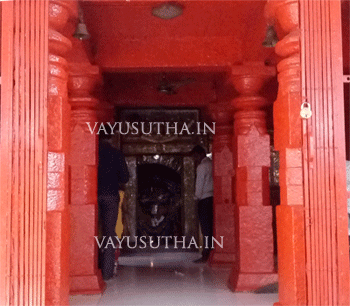 Just opposite this lamp pillar, one can see a sixteen-pillar hall situated about twenty feet away. The main deity of Sri Maruti is present in this 16-pillared mandapam. The arch above the mandapam has a Sri Rama parivar in mortar mold - stucco figure. The end of this mandapam makes the Garbhagraham. The pundit can enter the Garbhagraham through the side entrance. Devotees can have a clear darshan of the Sri Maruti from the lamp pillar onwards.
Just opposite this lamp pillar, one can see a sixteen-pillar hall situated about twenty feet away. The main deity of Sri Maruti is present in this 16-pillared mandapam. The arch above the mandapam has a Sri Rama parivar in mortar mold - stucco figure. The end of this mandapam makes the Garbhagraham. The pundit can enter the Garbhagraham through the side entrance. Devotees can have a clear darshan of the Sri Maruti from the lamp pillar onwards.
Sarangapur Sri Hanuman
While the Garbhagraham is facing west, Sri Hanuman is seen facing southwards. The lord’s left leg is seen raised and folded in such that the lord is ready for a quick step to help the devotee. The left lotus foot is seen raised above the ground. The right lotus foot of the Lord is seen firm on the ground. In His left arm, the Lord is holding mace [‘gada’]. His right arm is raised above and with the closed palm holding a ‘chapla’ [an instrument used during Bhajan]. His tail is raised just above His right hand. If keenly observed, the Lord seems to be in a joys mood chanting Sri Rama tharaka mantram and enjoying Ramanamamrutham [Rama-nama-amurtham]. The glow in His eyes and the slightly opened mouth and raised sharp ears are all indicating that he is immersed in ‘Ramanamtha-nishyantha-kanDam’.
Location of the temple: Hanuman Temple, Sarangapur, Telangana"
Experience
The village Sarangpur offers a conducive relaxed atmosphere optimal for offering prayers to Lord Maruti. This gives devotees a joy of immense pleasure. Following the darshan of Sri Maruti at Sarangpur, one is sure to feel tremendous satisfaction.
SRI HANUMAN THINKS DIFFERENTLY, THINKS FAST
THINKS AHEAD AND ACTS FOR SURE
Ed [October 2016]
Updates: [Jan 2025]
